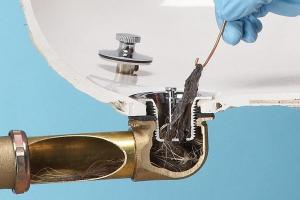Ultimate Guide to Fixing a Clogged Bathtub Drain Without Calling a Plumber

-
Quick Links:
- Understanding Clogs
- Tools You'll Need
- Step-by-Step Guide to Unclogging
- Preventative Measures
- When to Call a Plumber
- FAQs
Understanding Clogs
Clogs in bathtub drains are a common household issue that can disrupt your daily routine. Understanding how clogs form is the first step in effectively addressing them. Most clogs are caused by a buildup of hair, soap residue, and other debris. Over time, these materials accumulate, leading to slow drainage and eventual blockage.
Types of Clogs
- Hair Clogs: The most common type, especially in households with long hair.
- Soap Scum: Soap residue can build up and combine with hair to form a solid mass.
- Foreign Objects: Toys, jewelry, or other items can accidentally fall into the drain.
Tools You'll Need
Before you begin fixing your clogged bathtub drain, gather the following tools:
- Plunger
- Drain Snake
- Baking Soda
- Vinegar
- Hot water
- Bucket
- Rubber gloves
- Screwdriver
Step-by-Step Guide to Unclogging
Now that you have an understanding of clogs and the tools you'll need, follow these steps to unclog your bathtub drain:
Step 1: Remove the Drain Cover
Using a screwdriver, carefully remove the drain cover. Set it aside in a safe place.
Step 2: Use a Plunger
Place the plunger over the drain and create a tight seal. Push down and pull up rapidly to create suction. Repeat this process for about 5-10 minutes.
Step 3: Employ a Drain Snake
If plunging doesn’t work, try a drain snake. Insert the snake into the drain and twist it to break up the clog. Pull out any debris that comes with it.
Step 4: Baking Soda and Vinegar Method
For stubborn clogs, combine 1/2 cup of baking soda with 1/2 cup of vinegar. Pour it down the drain and let it fizz for 30 minutes. Follow it with hot water.
Step 5: Rinse with Hot Water
After using the baking soda and vinegar, flush the drain with hot water to clear any remaining debris.
Preventative Measures
To avoid future clogs, consider these preventative measures:
- Install a drain cover to catch hair and debris.
- Regularly clean the drain with baking soda and vinegar.
- Avoid pouring grease or thick substances down the drain.
When to Call a Plumber
If you’ve tried all of the above methods and your drain is still clogged, it may be time to call a plumber. Persistent clogs can indicate more serious plumbing issues that require professional intervention.
FAQs
1. How often should I clean my bathtub drain?
It's advisable to clean your bathtub drain every few months to prevent buildup.
2. Can I use chemical drain cleaners?
Chemical drain cleaners can be harmful to your plumbing and the environment. It's better to use natural methods first.
3. What if the clog is deep in the pipes?
For deep clogs, a professional plumbing service may have the equipment needed to resolve the issue.
4. Is it safe to use a plunger on a bathtub?
Yes, as long as you create a good seal and don’t use excessive force, plunging is safe for bathtubs.
5. How can I prevent hair clogs?
Use a drain cover to catch hair and clean it regularly.
6. What if my bathtub drain smells bad?
A bad smell may indicate stagnant water or buildup. Cleaning the drain with baking soda and vinegar can help.
7. Can I fix a clogged bathtub drain without tools?
While some methods can be done without tools, having basic plumbing tools will make the process easier and more effective.
8. How long does it take to unclog a bathtub drain?
The time it takes to unclog a drain varies by method, but most can be completed within 30 minutes to an hour.
9. Is it common for bathtub drains to clog?
Yes, clogged bathtub drains are a common household issue, especially in homes with long hair or heavy soap use.
10. What should I do if the clog keeps coming back?
If clogs recur often, consider inspecting your plumbing for underlying issues or consult a plumber.
Conclusion
Fixing a clogged bathtub drain can be a straightforward DIY task with the right tools and methods. By following this guide, you can save money on plumber fees and maintain your bathtub effectively. Remember to take preventative measures to avoid future clogs, and don't hesitate to call a professional if necessary.
References
- Family Handyman: How to Unclog a Bathtub Drain
- Home Depot: How to Unclog a Bathtub Drain
- Angie's List: How to Unclog a Bathtub Drain
Random Reads